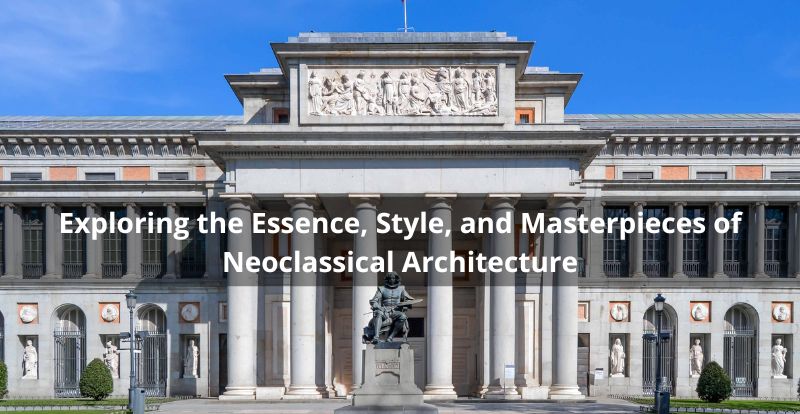Exploring the Essence, Style, and Masterpieces of Neoclassical Architecture
Exploring the Essence, Style, and Masterpieces of neoclassical architecture. Neoclassical architecture, also known simply as neoclassicism, emerged in the mid-18th century as a reaction against the ornate Rococo style. Derived from Palladian architecture, neoclassical works draw heavily from the architectural styles of ancient Rome and Greece.
The emergence of Neoclassical art is driven by a renewed fascination with the classical world, spurred by archaeological discoveries such as the excavations of Herculaneum and Pompeii. This movement also reflects a rejection of the ornate forms of the Baroque period, embracing instead the simplicity and harmony of ancient Greek and Roman aesthetics.
It may interest you: The Neoclassical Architecture: A Bridge to Modernity
Video: 10 Neoclassical Architecture & Decor

Knowing the Characteristics, Style, and Iconic Works
Neoclassical Architecture
The neoclassical movement emphasized the logic of entire classical volumes, in contrast to classical revivalism, which tended to reuse classical parts. The newfound appreciation for ancient simplicity represented a general reaction to the excesses of the Rococo style.
Spread and Influence of Neoclassical Architecture
Neoclassical architecture flourished in both the United States and Europe, with examples of its works found in almost every major city. Notably, St. Petersburg saw a proliferation of neoclassical-style buildings under the reign of Catherine II. Similarly, British architecture became dominated by neoclassicism in the early 19th century, with architects like Robert Adam and John Soane leading the way.
By 1800, almost all new British architecture reflected neoclassical spirit. In France, Claude-Nicolas Ledoux spearheaded a "second neoclassical wave," which was more studied and consciously archaeological, closely associated with the apex of the Napoleonic Empire. This phase is known as the "Directory" or "Empire" style, in contrast to the previous "Louis XVI" style.
In the United States, neoclassical architecture continued to thrive throughout the 19th century, as many architects sought to draw analogies between the young nation and the imperial Rome while designing key government buildings. The neoclassical style also extended to colonial Latin America.
Characteristics of Neoclassical Architecture
Neoclassical architecture is characterized by simplicity of geometric forms, grand scale of buildings, Greek details (particularly Doric), dramatic columns, and white walls.
Emphasizing simplicity of wall and its flatness, as well as the separation of elements, neoclassical style was seen as a reaction to the more luxurious excesses of Rococo.
Flat projections and recesses had different effects on light and shadow, and sculptural bas-reliefs were flatter and often framed in friezes, tablets, or panels. These individual characteristics were isolated and "complete in themselves," rather than integrated with other features.
Key elements of neoclassical architecture include:
1. Columns:
- Used to support the pediment and the entablature, columns are a common feature of neoclassical architecture.
2. Pediment:
- A decorative element found at the top of the facade, often featuring reliefs or sculptures.
3. Entablature:
- A set of decorative elements found beneath the pediment, including the frieze, cornice, and architrave.
4. Symmetry:
- An important characteristic of neoclassical architecture, aiming for the structure to be symmetrical and proportionate.
5. Classical Orders:
- Neoclassical architecture is based on classical orders, including Doric, Ionic, and Corinthian.
6. Decoration:
- Decoration is a key element of neoclassical architecture, often including reliefs and sculptures representing mythological or historical themes.
7. Flat Roofs:
- Flat roofs are characteristic of neoclassical architecture, as the structure aims to be proportionate and symmetrical.
8. Large Round Windows:
- A common feature of neoclassical architecture, aiming to allow natural light to illuminate the interior of the structure.
9. Modules:
- Used to measure decorative and structural elements, aiming for all elements to fit within a set measure.
10. Color Palettes:
- White and beige are predominant colors in neoclassical architecture, used to evoke a sense of elegance and sophistication.
Iconic Neoclassical Works
Notable examples of neoclassical or neoclassicism-influenced architecture include:
- Old Museum by Karl Friedrich Schinkel in Berlin
- Bank of England by Sir John Soane in London
- The White House in Washington DC
- The Pantheon in Paris
Types of Neoclassical Architecture
Neoclassical architecture can be divided into various types, including:
- Pure Neoclassical Architecture: Strictly follows the principles of classical architecture, using classical orders and mythological decoration.
- Academic Neoclassical Architecture: An evolution of pure neoclassicism, incorporating decorative and ornamental elements not found in classical architecture.
- Eclectic Neoclassical Architecture: A blend of architectural styles, incorporating elements from Gothic, Baroque, and Rococo architecture.
- Yorkine Neoclassical Architecture: Developed in England, characterized by the use of decorative and ornamental elements from Gothic architecture.
- American Neoclassical Architecture: An evolution of pure neoclassicism in America, characterized by the incorporation of decorative and ornamental elements unique to American architecture.
- Russian Neoclassical Architecture: Developed in Russia, characterized by the use of decorative and ornamental elements unique to Russian architecture.
- French Neoclassical Architecture: Developed in France, characterized by the use of decorative and ornamental elements unique to French architecture.
Neoclassical architecture stands as a testament to the revival of classical aesthetics in the modern era. With its emphasis on simplicity, symmetry, and grandeur, it continues to inspire architects and captivate admirers around the world. Through its iconic works and diverse interpretations, neoclassicism remains a timeless expression of architectural excellence.
Si quieres conocer otros artículos parecidos a Exploring the Essence, Style, and Masterpieces of Neoclassical Architecture puedes visitar la categoría Neoclassical.

Leave a Reply